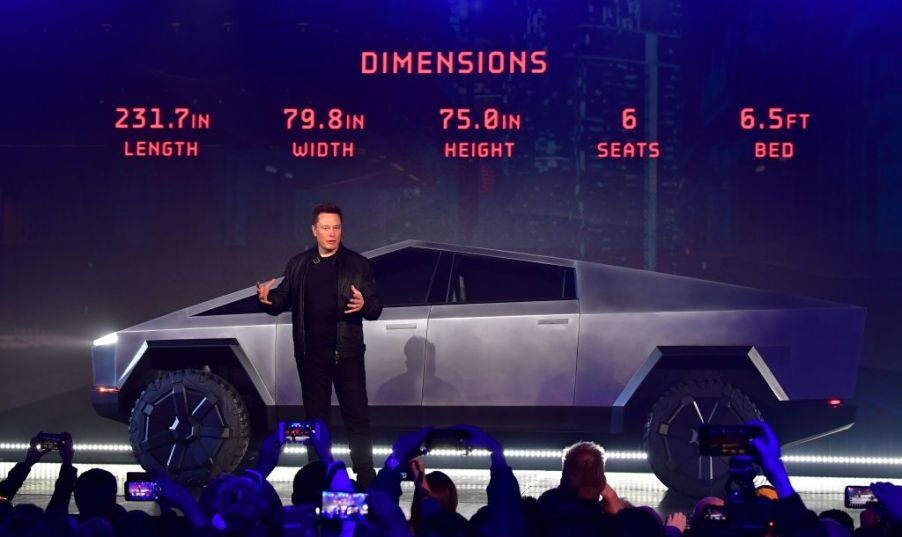
Why Tesla’s Cybertruck Tug-of-War Didn’t Really Prove Anything
If the recent viral video of the Tesla Cybertruck pulling a Ford F-150 had you scratching your head, you’re not alone. Yes, automakers are using some eye-catching novelties to promote electric vehicles these days. First, we saw the Ford F-150 electric pulling a million pounds and now the Tesla Cybertruck pulling the Ford F-150? Who won the Tesla tug-of-war?
The folks at the Engineering Explained YouTube Channel have broken down why the gimmicky video presentation didn’t really prove much of anything.
Understanding torque

The Tesla video might have you convinced that their Cybertruck wins because electric engines have the benefit of low-end torque. According to the folks at Engineering Explained (EE), that’s not what we actually saw.
So how does torque work? A regular vehicle’s torque starts at the engine before making its way through the gears which multiply it before it reaches the ground. The same is true for electric motors. The gears are what really provide wheel torque which is what propels the vehicle forward.
Tesla normally uses a single reduction gearbox with one speed that has a nine or ten to one gear ratio in its vehicles. Tesla’s electric motor sends torque to the gear reduction box and then it’s sent to the wheels. With the ten-to-one gear ratio, the motor torque gets multiplied ten times before arriving at the wheels.
The specs for the Ford truck used by Tesla weren’t known. But with internal combustion engines, torque is sent to a torque converter which can multiply it at a two-to-one ratio on average. There’s torque multiplication before it’s sent to the transmission. The Ford F-150 has a new 10-speed transmission that provides a 4.69-to-one gear ratio for the first gear.
From there, torque is sent to the rear differential for the final drive ratio. The folks at EE estimated the ratio to be 3.55-to-one. The Ford would have had more torque available in lower gears if the vehicle was using a four-wheel-drive platform.
The conclusion is that torque was not the reason you saw what you did in Tesla’s video. The Ford F-150 sends plenty of available torque to the wheels thanks to the multiplication of the torque using gearing in the drivetrain. If torque wasn’t the reason Tesla won, what was?
Maximum force
The trucks were back-to-back, fighting to go in the opposite direction of the other. The maximum force either vehicle is capable of producing, according to EE, is equal to the weight of the vehicle and the normal force multiplied by the tires’ frictional coefficient.
For their purposes, they assumed the tires of both trucks are equal with the same amount of grip. They also assumed that the Ford F-150 was a four-wheel-drive model and operating as such in the Tesla video even though their representative doubted that was true.
The example assumed that the Ford F-150 weighed 5,000 pounds. The maximum force the truck can use for acceleration equals the amount of weight on the wheels multiplied by the frictional coefficient. The weight of the Tesla was unknown, but since a Model X weighs 5,500 pounds, it can be assumed they used the dual-motor out of the three Cybertruck options. EE estimated it to be 6,000 pounds or more. Tesla has the weight advantage and is able to put down a lot more force since it’s heavier.
Watching the Tesla video, EE points out that the F-150 appears to be a rear-wheel-drive model if you watch the way the tires spin. There’s also nothing to indicate that it’s a 4×4 model. With the Ford F-150’s weight distribution of 60% in the front and 40% in the back, there’s only 40% of the weight on the driven tires in the rear to accelerate with. Doing the math, 40% of 5,000 pounds is 2,000, so that’s how many pounds the Ford F-150 had to accelerate with versus the 6,000 pounds wielded by Tesla. There’s no competition there.
Pulling angles
If we assume that Tesla was honest in their filming angles, according to EE, they really did pull the F-150 uphill. For this, EE used a 5-degree angle or an 8.75% grade – that’s steeper than an industry-standard towing test for the analysis. They also assumed there’s no load and didn’t factor in any rolling resistance. The F-150 has a force of 2,000 pounds and it’s multiplied by a cosine of five which gives 1,992 pounds of force.
Tesla’s Cybertruck, going uphill, has a force of 6,000 pounds multiplied by a cosine of five to give it 5,997 pounds of force. The gravity working against the Tesla truck was factored in at a force of 959 pounds. The ending conclusion is that Tesla has an advantage of 3,026 pounds, proving that it was incredibly easy for Tesla to pull the Ford F-150 because it’s heavier.
Conclusion
All Tesla’s video really proved was that the Cybertruck is heavy. And that’s not necessarily a good thing as a heavier vehicle means it takes more energy to move it. It can also cause performance and handling to suffer.
Was it smart marketing on Tesla’s part? Yes, because most people aren’t going to take the time to think it through and do the math. They are going to take away from the video that the Tesla Cybertruck has shown up the popular Ford F-150.
Marketing, however, doesn’t change the fact that Tesla’s new truck is going to be a hard sell for traditional truck owners. The design is controversial, and there’s no easy access to the bed to grab something that you may need to work on as you can with a regular truck.
If Tesla sincerely wants to try to bring regular truck owners over to an electric truck at a fair price, it may want to focus less on innovative and unusual styling and focus more on what truck owners actually want.


